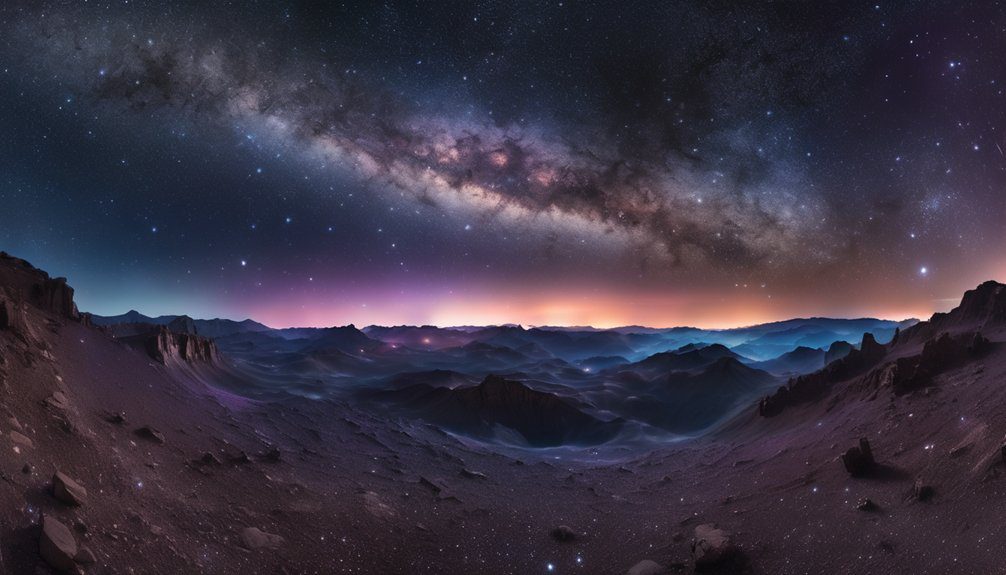You can map the Milky Way by studying its spiral arms, dense with stars and gas, and the galactic center, home to a supermassive black hole obscured by dust. However, much remains hidden because dark matter, making up most of the galaxy’s mass, is invisible and interstellar dust clouds block light. The outer halo, with sparse stars and dark matter, adds complexity. Understanding these layers reveals a clearer picture, with more details to explore ahead.
The Spiral Arms and Stellar Distribution
Although you can’t see the Milky Way’s structure directly from Earth, astronomers have mapped its spiral arms by studying the distribution of stars and other matter.
These arms form distinct patterns where stars, gas, and dust cluster more densely than in surrounding regions. You’ll find that the spiral arms aren’t rigid structures but dynamic, shaped by gravitational forces and star formation processes.
The Galactic Center and Its Complexities
When you look toward the center of the Milky Way, you encounter a region unlike any other part of the galaxy. This area, known as the Galactic Center, houses a supermassive black hole surrounded by dense star clusters, clouds of gas, and intense radiation.
The environment is chaotic, with stars orbiting rapidly and interstellar matter interacting dynamically. Observing this zone challenges astronomers due to dust and gas obscuring visible light, requiring infrared and radio waves for clearer views.
Understanding the Galactic Center helps you grasp the forces shaping our galaxy’s core and its influence on overall structure and evolution.
Mapping Dark Matter in Our Galaxy
Scientists estimate that about 85% of the matter in the Milky Way is dark matter, an invisible substance that doesn’t emit or absorb light.
You can’t see it directly, but its presence becomes clear by observing how stars and gas move within the galaxy. By measuring these motions, you map the gravitational effects dark matter creates. This helps you infer its distribution and overall shape.
Although you can’t detect dark matter with traditional telescopes, its gravitational influence acts as a guide, allowing you to piece together a more complete picture of our galaxy’s structure.
Challenges Posed by Interstellar Dust
Since interstellar dust absorbs and scatters light from stars and other celestial objects, it creates significant obstacles for mapping the Milky Way accurately.
When you study our galaxy, you face three main challenges caused by this dust:
- Obscured visibility – Dust clouds block your view of distant stars, hiding parts of the galaxy.
- Distorted measurements – Light dimming and reddening affect how you determine distances and properties of celestial bodies.
- Complex corrections – You must apply models to adjust for dust effects, which can introduce uncertainties.
Understanding these challenges helps you interpret Milky Way maps more reliably.
Exploring the Outer Halo and Beyond
Mapping the Milky Way requires looking beyond the dusty regions that obscure our view, extending your observations to the galaxy’s outer halo and the space beyond.
This vast area consists mainly of sparse stars, globular clusters, and dark matter, which influence the galaxy’s shape and motion. By studying the outer halo, you can uncover clues about the Milky Way’s formation and its interactions with nearby galaxies.
Although these regions are faint and difficult to observe, advances in telescopes and surveys are gradually revealing their structure.
Exploring beyond offers a broader perspective on our galaxy’s place in the universe.
Frequently Asked Questions
How Did the Milky Way Galaxy Form Initially?
You’ll see the Milky Way formed when gravity pulled gas and dust together, sparking star birth. Over time, these stars and clouds merged, creating the galaxy’s spiral shape you explore today, always evolving and free.
What Is the Estimated Age of the Milky Way?
You’ll find the Milky Way is about 13.6 billion years old. It’s almost as ancient as the universe itself, giving you a glimpse into the vast history that shaped your cosmic neighborhood.
Are There Any Known Exoplanets Within Our Galaxy?
Yes, you can find thousands of known exoplanets within our galaxy. Scientists have discovered them orbiting various stars, proving that planets beyond our solar system are common and waiting for you to explore their mysteries.
How Do Black Holes Affect the Milky Way’s Evolution?
Black holes shape the Milky Way by pulling in gas and stars, fueling star formation, and regulating galaxy growth. You’ll see their powerful gravity influences how our galaxy evolves over time, keeping cosmic balance intact.
What Future Missions Aim to Improve Milky Way Mapping?
You’ll want to watch missions like Gaia’s next data releases, the James Webb Space Telescope, and upcoming radio arrays. They’re set to sharpen our Milky Way maps, filling gaps and revealing hidden structures you can explore freely.
